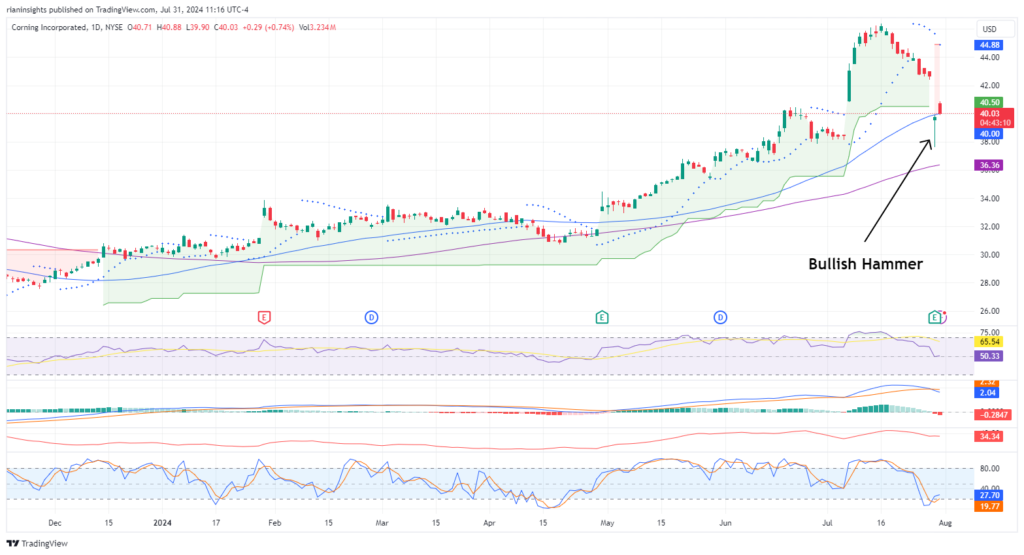Deutsche Bank upgraded Corning Inc. (NYSE: GLW) to a Buy from Hold, with a new price target of $46, on July 31, 2024. This revision comes in the wake of Corning’s Q2 earnings report released a day prior.
Analysts’ views
Deutsche Bank’s optimism is pinned on the projected double-digit EPS growth over the next few years, particularly spotlighting Corning’s optical segment which is forecasted to grow at a 13% CAGR from 2024 to 2027.
The firm attributes this growth to two main drivers: the rapid uptake of Corning’s optical connectivity products for generative AI and an increase in carrier activities after a period of inventory corrections.
In contrast to Deutsche Bank’s positive outlook, earlier assessments from other firms painted a varied picture.
On June 13, 2024, Morgan Stanley downgraded Corning to Equal-weight from Overweight but increased their price target to $38, citing a balanced risk-reward scenario despite potential upsides.
They acknowledged potential growth from service provider enhancements expected later in 2024 and from AI data center expansions but also noted challenges like currency risks and valuation concerns.
Similarly, Mizuho Securities issued a Neutral rating with a $36 price target on May 7, 2024, pointing out unusual currency risks as a significant concern.
Their cautious stance hinges on potential recoveries in Asian currencies and Corning’s ability to manage price increases in display glass without losing market share.
Q2 earnings in detail
Corning’s Q2 performance itself was robust, with a Non-GAAP EPS of $0.47 aligning with expectations and a revenue of $3.6 billion, which was a $20 million beat over forecasts.
The company’s outlook for Q3 suggests core sales reaching approximately $3.7 billion, with EPS growth outpacing sales, primarily driven by continued strong demand for its optical connectivity solutions catered to generative AI.
Financially, Corning appears solid. The second-quarter results reflect strategic advances under its ‘Springboard’ plan, which aims to add more than $3 billion in annualized sales with strong incremental profits and cash flows over the next three years.
These results were supported by new agreements, such as with Lumen Technologies, to reserve significant fiber capacity for interconnecting AI-enabled data centers.
At the core of Corning’s growth is its Optical Communications segment, which has seen substantial demand due to the increasing necessity for data center expansions and enhanced fiber connectivity solutions.
This demand is further catalyzed by the AI-driven market, where Corning’s innovative products, such as pre-connectorized structured cabling solutions and RocketRibbon cables, offer substantial advantages in terms of installation time and performance efficiency.
These innovations not only meet the current high-density requirements of modern data centers but also position Corning as a key player in a rapidly evolving industry.
In terms of valuation, despite the recent upticks in stock price, which some analysts attribute to speculative AI bubble dynamics, Corning’s long-term valuation metrics remain grounded in its operational performance and market expansion strategies.
The company has managed to maintain a healthy balance between innovation-led growth and financial prudence, ensuring robust gross margins and operational efficiencies.
As we pivot to the technical analysis of Corning’s stock, we aim to examine how these robust fundamentals are mirrored in its market performance.
This analysis will help us understand the trajectory Corning’s stock might take in the coming months.
Bullish hammer on daily charts
After a substantial 50% surge this year, Corning’s stock witnessed a heavy fall yesterday as the company disclosed its Q2 earnings.
However, investors bullish on the stock don’t need to be concerned because the stock ended the day by forming a hammer pattern on the charts.
A hammer chart pattern looks like a hammer with a short body and a long lower wick, appearing during a downtrend to suggest a potential reversal or support, indicating that buyers are starting to outweigh sellers.

Taking this pattern into account, investors and short-term traders who are looking to buy the stock can do so at current levels near $40 with a stop loss below yesterday’s low at $37.5.
Traders who are bearish on the stock must wait for the stock to fall below yesterday’s low to initiate a short position.
The post Deutsche Bank thinks Corning’s stock can reach $46: Should you buy? appeared first on Invezz

